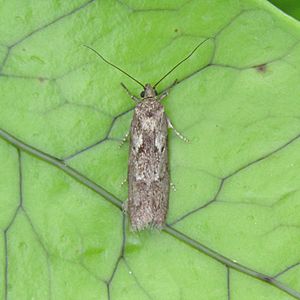Chersadaula ochrogastra facts for kids
Quick facts for kids Chersadaula ochrogastra |
|
|---|---|
 |
|
| Scientific classification | |
| Kingdom: | |
| Phylum: | |
| Class: | |
| Order: | |
| Family: |
Oecophoridae
|
| Genus: |
Chersadaula
|
| Species: |
C. ochrogastra
|
| Binomial name | |
| Chersadaula ochrogastra Meyrick, 1923
|
|
| Synonyms | |
|
|
Chersadaula ochrogastra is a special kind of moth found only in New Zealand. It belongs to a group of moths called Oecophoridae. This moth is quite rare, and scientists don't have much information about it, which is why it's listed as "Data Deficient" by the New Zealand Department of Conservation.
Contents
Discovering the Moth
This moth was first described by a scientist named Edward Meyrick in 1923. He studied specimens that another scientist, George Hudson, had collected. George Hudson found the young moths (larvae) in September and watched them grow into adult moths in November. He even wrote about and drew this moth in his 1928 book, The Moths and Butterflies of New Zealand. The original specimen, called the lectotype, is kept safe at the Natural History Museum, London.
What Does It Look Like?
Eggs
The eggs of this moth are white and shaped like tiny cylinders, about 3 millimeters long. They are a bit wider at one end.
Larvae (Caterpillars)
When fully grown, the larvae (which are like caterpillars) are about 2 centimeters long. They are also cylinder-shaped but get narrower at one end. Their heads are a bright yellowish-brown. The front part of their body is yellowish-white, then it turns a bit black, and the rest is whitish with irregular patches of chocolate brown.
Adult Moths
The adult moths are generally light brownish with hints of rosy-pink. They also have tiny grey-whitish and dark brownish-black specks.
- Male Moths: They are about 1.7 centimeters long. Their forewings are long and slightly curved.
- Female Moths: They are slightly smaller, about 1.6 centimeters long. Their forewings are wider and come to a sharp point. Interestingly, the female moths have much smaller hindwings and cannot fly!
Where Does It Live?
This moth is endemic to New Zealand, meaning it's found nowhere else in the world. So far, it has only been found in the North Island. The last time this species was collected was in 1923, which means it's been a very long time since anyone has seen one!
Life and Habits
Scientists have found the larvae of this moth living under stones. The adult moths usually appear in early November. As mentioned, the adult female moths of this species cannot fly because their wings are too small.
Home and Food
The female moths lay their eggs freely, not attaching them to anything specific. The larvae of this moth live in silky cocoons underground. They eat the roots of grasses. Their favorite place to live is along the sea-coast, usually about three meters above where the high tide reaches.
Protecting the Moth
This species is currently listed as "Data Deficient" under the New Zealand Threat Classification System. This means that scientists don't have enough information to know if the moth is endangered or not. More research is needed to understand its population and how to protect it.

